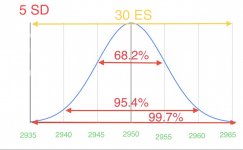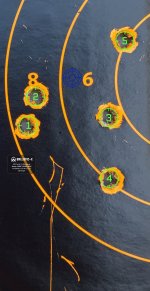So im kind of stuck figuring out why i have a lousy ES.
6.5 Lapua W/Lapua brass.
I have two nodes @ 40.7 grains and 41 grains
Below is a pretty typical read shot string
#1 - 2889
#2 - 2896
#3 - 2902
#4 - 2899
#5 - 2882
#6 - 2894
#7 - 2881
#8 - 2888
#9 - 2887
#10 - 2894
SD - 6.9
ES - 21
Brass is 3 times fired
I size the cases with a redding type s full length die shoulder bumped back 2 thou
I then run them through a LE Wilson Neck sizing mandrel
Ive been measuring powder through a chargemaster and then checking on a second scale to make sure there is no funny business going on with the scales and they match up perfectly.
I seat them with redding micrometer die. with around 4 thou jump from my seating depth test gave me .33 MOA.
Before winter set in down here it was at single digit SD and ES's and the same for my 6 BR but both had ES's shoot way up to the 30's and i cant figure out whats going on.
6.5 Lapua W/Lapua brass.
I have two nodes @ 40.7 grains and 41 grains
Below is a pretty typical read shot string
#1 - 2889
#2 - 2896
#3 - 2902
#4 - 2899
#5 - 2882
#6 - 2894
#7 - 2881
#8 - 2888
#9 - 2887
#10 - 2894
SD - 6.9
ES - 21
Brass is 3 times fired
I size the cases with a redding type s full length die shoulder bumped back 2 thou
I then run them through a LE Wilson Neck sizing mandrel
Ive been measuring powder through a chargemaster and then checking on a second scale to make sure there is no funny business going on with the scales and they match up perfectly.
I seat them with redding micrometer die. with around 4 thou jump from my seating depth test gave me .33 MOA.
Before winter set in down here it was at single digit SD and ES's and the same for my 6 BR but both had ES's shoot way up to the 30's and i cant figure out whats going on.




